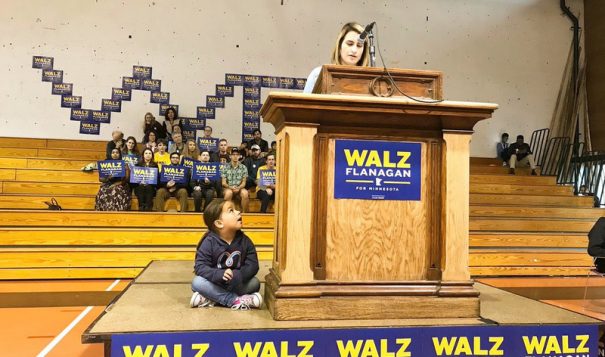 Rep. Peggy Flanagan speaking at a campaign event. She Tweeted: "My fave photo from our kickoff. I'm running for my little girl and all girls who deserve to be seen, heard and valued." (Photo via Twitter)
Rep. Peggy Flanagan speaking at a campaign event. She Tweeted: "My fave photo from our kickoff. I'm running for my little girl and all girls who deserve to be seen, heard and valued." (Photo via Twitter)
Mark Trahant / Trahant Reports
The November election seems far off. It’s almost a year away, right? Sorry. Elections are a series of steps that lead to that moment when ballots are actually counted.
And for the #NativeVote18 candidates some of those early steps are real tests. And in Minnesota one of those critical tests is Feb. 6.
So far there are 15 Native candidates on my national list, people running for office statewide or for a seat in the U.S. House of Representatives. That’s extraordinary and compelling when you think about it. There are two candidates for state governors, two for Lt. Governors, eight running for Congress, one for the U.S. Senate, and two for attorney general and secretary of state. Seven of the candidates are Democrats, 5 Republicans, and 2 Green Party candidates and one independent. That’s a lot of diversity in thought, geography, and, of course, culture.
Back to that test. Voters in Minnesota will caucus at the precinct level. It’s a meeting that is run by a political party. Here is how it works (from the Secretary of State’s office): “We encourage Minnesotans to show support for their preferred candidates by participating in the candidate endorsement process that leads up to the state party conventions. It all begins on Tuesday, February 6, 2018 with the precinct caucuses. Going to a caucus is a great way to show support for a candidate, raise an issue that’s important to you, influence who the party will endorse for many offices, and meet people in your community.”
There are two important things that happen at these precinct-level meetings. First there will be a “preference” vote for governor. The winner of that poll could use it to help raise money and suggest a larger base of support. The second thing is the election of delegates to the state convention. This is the big deal. Because in Minnesota state party delegates will later endorse a candidate before the primary.
A precinct caucus can be won by a small group. Basically if someone decides to take a bunch of friends to a meeting — that could change everything. That’s especially true in this year’s election because both parties have so many candidates running. A small, dedicated group of friends could win an election. Literally. (Said in a Rob Lowe voice.)
On the Democratic side (the Democratic Farmer Labor Party) there are six plus candidates, a mayor, three legislators, a state auditor, and a member of Congress.
And Rep. Tim Walz is campaigning with his pick for Lt. Gov, Rep. Peggy Flanagan. Flanagan is a member of the White Earth band of Ojibwe. And she would be the first Native American woman to hold this office. This is unusual for a team to be put together so early, but it’s also an opportunity for voters to see what an administration would look like. And for the team to balance each other in terms of interest and perception.
That’s already been an issue. Rebecca Otto, the state auditor and a DFL candidate for governor, says she is running to be the most progressive candidates. In a fundraising letter she she has “strong disagreements” with Walz because he voted for Keystone XL three times in Congress, supports the Enbridge Pipeline and “says he does not oppose the DAPL pipeline.” As is often the case, the story is more complicated than that. It’s true that Walz voted for Keystone, but he also has said that if any pipeline negatively impacts Native people, violates treaty rights, or disturbs burial grounds, it should not be built.
There are two political tactics at work here: Otto’s team is eager to weaken support for Walz-Flanagan in Native communities and discount Flanagan’s role by only focusing on Walz’ record in Congress.
But Walz and Flanagan are running together early — so voters should judge both of them. Together. Should Walz be elected, Flanagan would be there to make the case. She would be inside the room. She might win the day. She might not. But she’ll be there for four years pushing and reminding Walz about the importance of Native issues. Especially pipelines.
Tuesday’s precinct caucus will be a test not only for Walz and Flanagan but that of voters from Native communities in Minnesota. A precinct caucus is the perfect forum for Indian Country because a small dedicated group can win.
There are also nine Republicans running in their party caucus Tuesday. Last week former Gov. Tim Pawlenty signaled that he might try one more time.
Mark Trahant is an independent journalist and a member of The Shoshone-Bannock Tribes. On Twitter @TrahantReports

